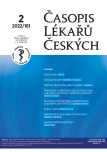Diagnostic methods of fatty liver diseases
Authors:
Karel Dvořák
Authors‘ workplace:
Oddělení gastroenterologie a hepatologie, Krajská nemocnice Liberec, a. s.
Published in:
Čas. Lék. čes. 2022; 161: 57-60
Category:
Review Article
Overview
Fatty liver diseases represent the most common chronic liver diseases today. Therefore, the diagnostics of fatty liver is of great importance. Sonography is the most used imaging method in daily clinical practice for its availability and good diagnostic performance. But there are limitations in lower sensitivity in mild steatosis and in subjects with more severe obesity. Sonographic findings of fatty liver include higher echogenity of liver parenchyma and attenuation of ultrasound waves in deeper parts of the liver. Furthermore, there are some other advanced methods for semiquantitative and quantitative assessment of the amount of the liver fat. Many of them are based on acoustic signal attenuation assessment. The most broadly used is a CAP (controlled attenuation parameter) feature of FibroScan, which can assess fatty liver without classic ultrasound examination. Thera are also special MR based techniques – MR spectroscopy and PDFF (protein density fat fraction) which allow liver fat quantification with high precision and can be used as a reference standard.
Keywords:
magnetic resonance – Fatty liver – quantification – diagnostics – sonography
Sources
1. Kleiner DE, Brunt EM, Van Natta M et al. Design and validation of a histological scoring system for nonalcoholic fatty liver disease. Hepatology 2005; 41(6): 1313–1321.
2. Hernaez R, Lazo M, Bonekamp S et al. Diagnostic accuracy and reliability of ultrasonography for the detection of fatty liver: a meta-analysis. Hepatology 2011; 54(3): 1082–1090.
3. Ferraioli G, Berzigotti A, Barr RG et al. Quantification of liver fat content with ultrasound: a WFUMB position paper. Ultrasound Med Biol 2021; 47(10): 2803–2820.
4. de Moura Almeida A, Cotrim HP, Barbosa DB et al. Fatty liver disease in severe obese patients: diagnostic value of abdominal ultrasound. World J Gastroenterol 2008; 14(9): 1415–1418.
5. Dietrich CF, Shi L, Lowe A et al. Conventional ultrasound for diagnosis of hepatic steatosis is better than believed. Z Gastroenterol 2021, doi: 10.1055/a-1491-1771.
6. Marshall RH, Eissa M, Bluth EI, Gulotta PM, Davis NK. Hepatorenal index as an accurate, simple, and effective tool in screening for steatosis. Am J Roentgenol 2012; 199(5): 997–1002.
7. Moret A, Boursier J, Houssel Debry P et al. Evaluation of the hepatorenal B-mode ratio and the "controlled attenuation parameter" for the detection and grading of steatosis. Ultraschall Med 2020, doi: 10.1055/a-1233-2290.
8. Karlas T, Petroff D, Sasso M et al. Individual patient data meta-analysis of controlled attenuation parameter (CAP) technology for assessing steatosis. J Hepatol 2017; 66(5): 1022–1030.
9. Caussy C, Alquiraish MH, Nguyen P et al. Optimal threshold of controlled attenuation parameter with MRI-PDFF as the gold standard for the detection of hepatic steatosis. Hepatology 2018; 67(4): 1348–1359.
10. Petroff D, Blank V, Newsome PN et al. Assessment of hepatic steatosis by controlled attenuation parameter using the M and XL probes: an individual patient data meta-analysis. Lancet Gastroenterol Hepatol 2021; 6(3): 185–198.
11. Pu K, Wang Y, Bai S et al. Diagnostic accuracy of controlled attenuation parameter (CAP) as a non-invasive test for steatosis in suspected non-alcoholic fatty liver disease: a systematic review and meta-analysis. BMC Gastroenterol 2019; 19(1): 51.
12. Tamaki N, Koizumi Y, Hirooka M et al. Novel quantitative assessment system of liver steatosis using a newly developed attenuation measurement method. Hepatol Res 2018; 48(10): 821–828.
13. Cerit M, Sendur HN, Cindil E et al. Quantification of liver fat content with ultrasonographic attenuation measurement function: correlation with unenhanced multidimensional computerized tomography. Clin Imaging 2020; 65 : 85–93.
14. Noureddin M, Lam J, Peterson MR et al. Utility of magnetic resonance imaging versus histology for quantifying changes in liver fat in nonalcoholic fatty liver disease trials. Hepatology 2013; 58(6): 1930–1940.
Labels
Addictology Allergology and clinical immunology Angiology Audiology Clinical biochemistry Dermatology & STDs Paediatric gastroenterology Paediatric surgery Paediatric cardiology Paediatric neurology Paediatric ENT Paediatric psychiatry Paediatric rheumatology Diabetology Pharmacy Vascular surgery Pain management Dental HygienistArticle was published in
Journal of Czech Physicians

2022 Issue 2
Most read in this issue
- Liver tests
- Alcohol-related liver disease in medical practice
- Liver elastography
- Metabolic dysfunction-associated fatty liver disease (MAFLD) as a more accurate name for NAFLD – common aspects of pathogenesis
